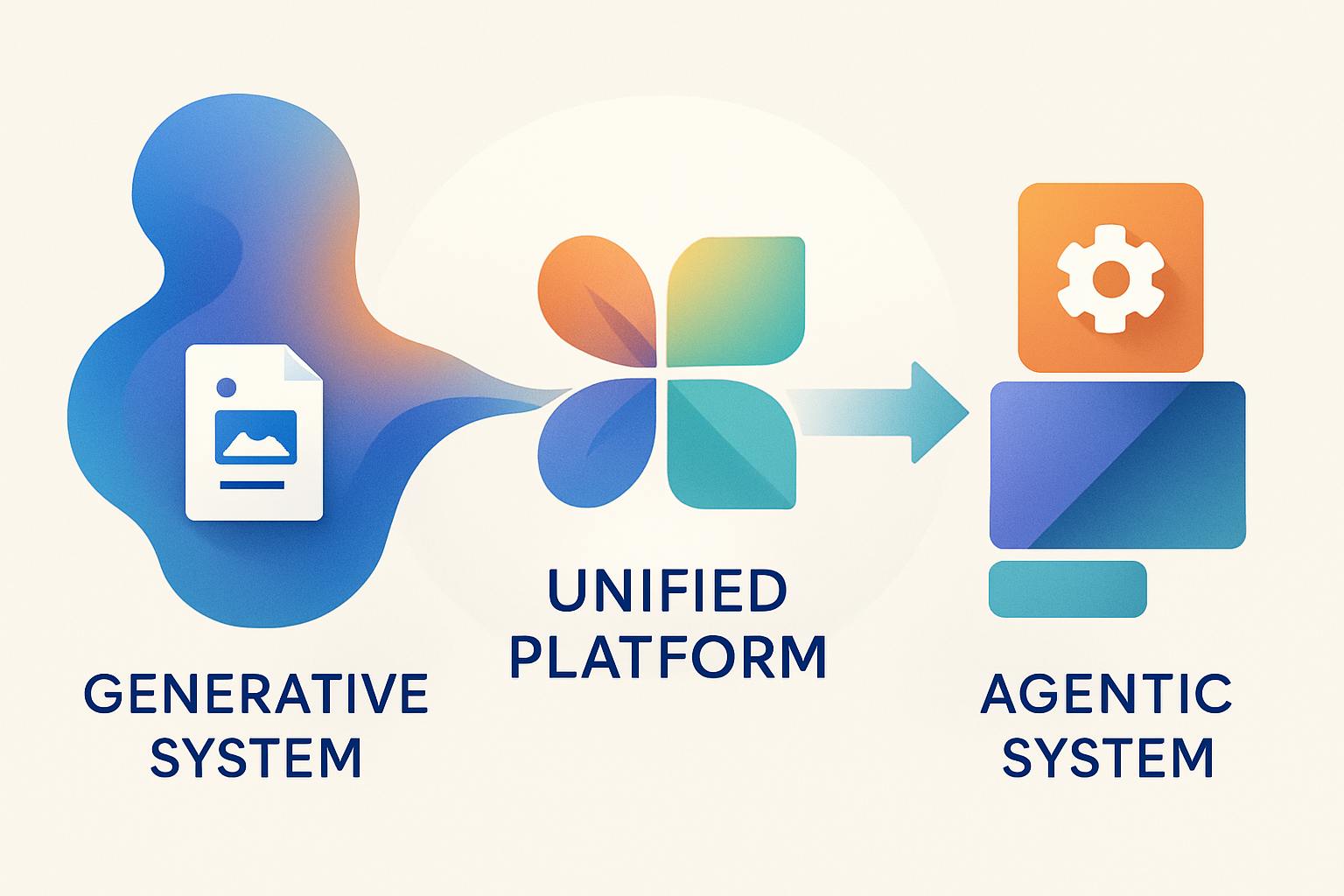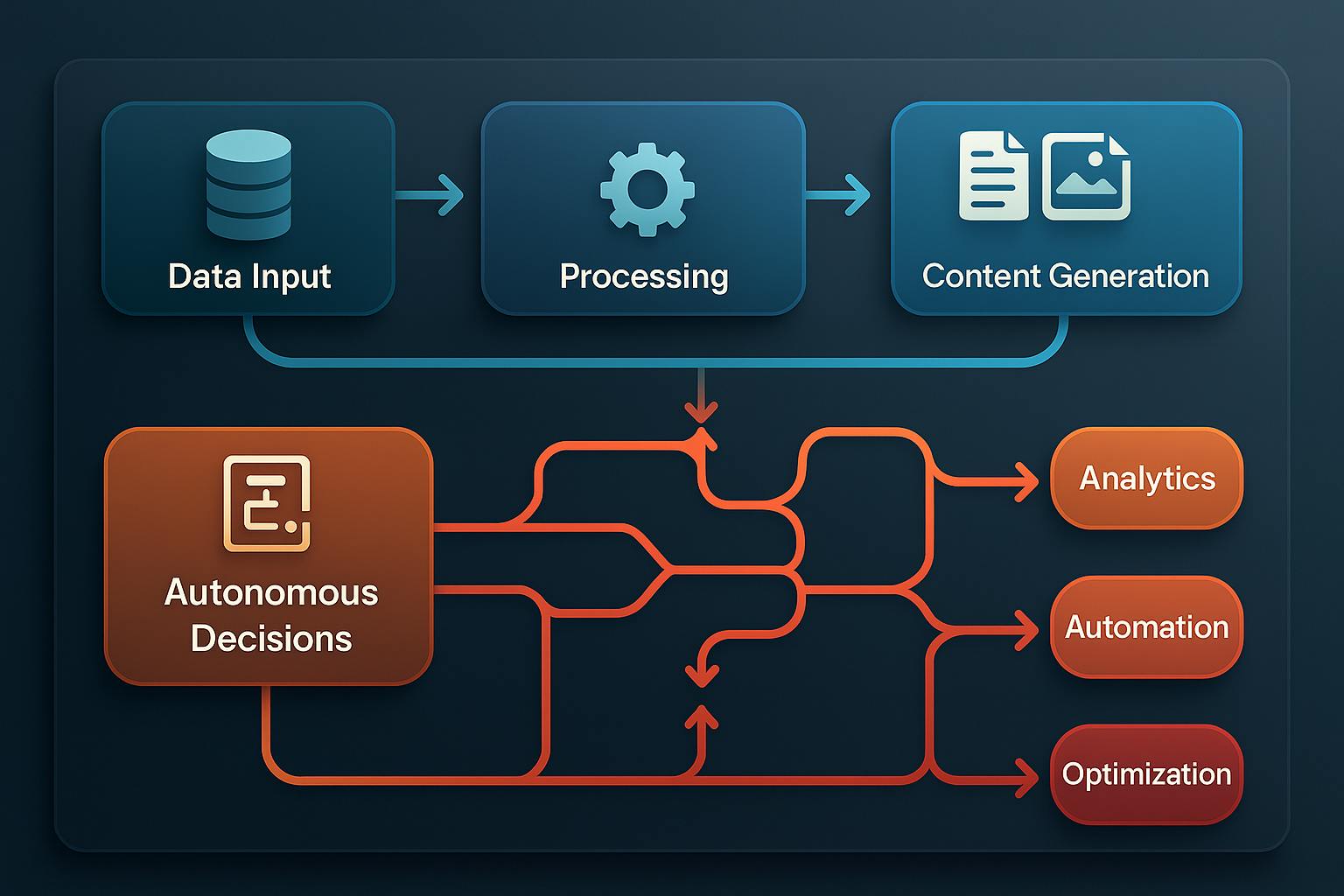Table of contents :
Agentic AI vs generative AI: complete comparison
Complete guide comparing agentic AI and generative AI. Discover the differences, applications and synergies between these two artificial intelligence paradigms to optimize your business strategy.
Complete guide comparing agentic AI and generative AI. Discover the differences, applications and synergies between these two artificial intelligence paradigms to optimize your business strategy.
Two paradigms redefining artificial intelligence
The difference between agentic AI and generative AI now structures the enterprise artificial intelligence ecosystem. These two distinct approaches are radically transforming how organizations integrate AI into their business processes and innovation strategies.
According to the latest industry studies, 78% of French companies plan to adopt generative vs agentic artificial intelligence solutions. Integrating these technologies within an AI Hub allows for centralizing innovations and accelerating their deployment. Understanding this fundamental distinction becomes crucial for optimizing your technology strategy and maximizing ROI on your AI projects. By leveraging an AI Hub, companies benefit from an agile and scalable structure capable of addressing current artificial intelligence challenges.
The generative AI definition focuses on creating original content, while the agentic AI definition prioritizes decision-making autonomy and proactive action. This comprehensive comparison will help you choose between agentic AI and generative AI based on your specific business objectives.
Generative AI: creative mastery and content generation
Generative AI definition and technical functionality
Generative AI represents a category of artificial intelligence specialized in automatic content creation from massive datasets. These systems use advanced generative AI models, including transformers, generative adversarial networks (GANs) and diffusion models to produce original content.
The agentic AI vs generative AI functionality reveals a fundamental architectural difference. Generative AI relies on deep learning and natural language processing (NLP) to analyze patterns in training data and generate coherent content in response to user prompts.
Technical characteristics of generative AI models
Architecture based on Large Language Models (LLMs): Modern generative AI models integrate transformer architectures with billions of parameters, enabling sophisticated contextual understanding and high-quality content generation.
Supervised and unsupervised learning: Combination of deep learning techniques including transfer learning, fine-tuning and reinforcement learning from human feedback (RLHF) to improve relevance and safety of generations.
Multimodal capabilities: Emerging multimodal models integrate text, image, audio and video in a unified architecture, significantly expanding creative possibilities.
Business applications of generative AI for content creation
Digital marketing and communications: Generative AI for automatic content creation including blog articles, product descriptions, personalized advertising campaigns and social media content. Marketing teams observe a 60% productivity increase with these tools.
Assisted software development: Automatic code generation, technical documentation, unit tests and intelligent debugging. Developers accelerate their development cycles by 40% thanks to generative AI assistance.
Personalized training and education: Creation of adaptive educational materials, personalized assessments, learning simulations and multilingual content for employee continuous training.
Agentic AI: decision-making autonomy and proactive action
Agentic AI definition and technical specifications
Agentic AI refers to conversational artificial intelligence systems capable of acting autonomously to achieve complex objectives. These intelligent AI agents combine environmental perception, logical reasoning, strategic planning and action execution in dynamic contexts.
The architecture of multi-agent systems integrates several specialized components: central reasoning engine, perception modules, interaction tools, contextual memory and reinforcement learning mechanisms for continuous performance improvement.
Distinctive capabilities of agentic artificial intelligence
Advanced decision-making autonomy: Intelligent AI agents analyze complex situations, evaluate available options and make strategic decisions without constant human supervision. This autonomy extends to multi-step planning and dynamic strategy adjustment.
Adaptive reinforcement learning: Use of reinforcement learning to continuously optimize behaviors based on environmental feedback. Agents learn from their experiences and improve their performance autonomously.
Business process orchestration: Ability to coordinate distributed multi-agent systems, manage complex workflows and optimize resource allocation according to predefined performance criteria.
Advanced agentic AI enterprise applications
Intelligent supply chain management: Best agentic AI enterprise applications include automated inventory optimization, shortage prediction, supplier negotiation and order adjustment based on real-time demand fluctuations.
Autonomous conversational customer service: Intelligent conversational agents capable of solving complex multi-step problems, automatically escalating critical cases and learning from interactions to continuously improve customer satisfaction.
Automated predictive financial analysis: Market surveillance, investment opportunity detection, portfolio management and transaction execution according to predefined risk and performance criteria.
Technical differences agentic generative AI: in-depth comparison
Architecture and technological complexity
Generative AI: Architecture centered on a single Large Language Model optimized for content generation. Complexity lies in model size (up to 1 trillion parameters) and training data quality. Required infrastructure focuses on GPU computing power for fast inference.
Agentic AI: Distributed modular architecture integrating multiple specialized components. Complexity distributed between perception, reasoning, memory and action. Requires more sophisticated infrastructure to manage multi-system interactions and continuous reinforcement learning.
Interaction modes and usage paradigms
Generative artificial intelligence operates according to a question-answer paradigm where the user formulates specific requests and receives generated content. Interaction remains punctual and requires human intervention for each creative task.
Agentic artificial intelligence operates proactively, continuously monitoring its environment and triggering actions according to predefined objectives. Interaction becomes collaborative, with the agent actively participating in complex problem-solving.
Comparative performance and operational efficiency
Generative AI performance metrics:
- Generated content quality (coherence, creativity, factual accuracy)
- Generation speed and production throughput (tokens/second)
- Personalization capability according to business contexts
- Cost per generation and energy efficiency
Agentic AI performance indicators:
- Success rate in achieving complex multi-step objectives
- Adaptation capacity to environmental changes
- Multi-agent collaboration efficiency
- Agentic AI vs generative AI enterprise ROI on automated processes

How agentic AI vs generative AI works: internal mechanisms
Generative AI processing workflow
Encoding phase: Natural language processing (NLP) analyzes the user prompt, identifies entities, understands intent and activates relevant neurons in the transformer network.
Probabilistic generation: The model sequentially predicts the next token according to calculated probabilities, using sampling techniques (temperature, top-k, nucleus) to control creativity and coherence.
Post-processing and validation: Security filtering, coherence verification and optimization according to user preferences defined during RLHF training.
Agentic AI decision-making mechanisms
Perception and environmental analysis: Sensors collect multi-source data, perception modules analyze current state and identify significant changes requiring action.
Planning and optimization: The agent evaluates available options, simulates potential consequences and selects optimal strategy according to its objectives and operational constraints.
Execution and learning: Implementation of planned actions, results monitoring and internal model updates via reinforcement learning to improve future performance.
Agentic AI autonomous decision-making advantages vs creative generation
Specific generative AI content creation benefits
Multiplied creative productivity: 70% acceleration of content creation processes, allowing creative teams to focus on strategy and innovation rather than repetitive execution.
Large-scale personalization: Generation of personalized content for thousands of customer segments simultaneously, with automatic adaptation of tone, style and message according to defined personas.
Reduced operational costs: 50% decrease in marketing and technical content production costs, while maintaining quality and accelerating delivery times.
Distinctive agentic AI enterprise advantages
Complex process automation: Agentic AI autonomous decision-making advantages include end-to-end management of multi-step workflows without human intervention, reducing errors and accelerating operational cycles.
Continuous performance optimization: Automatic improvement of business processes through performance data analysis and strategy adjustment according to defined objectives.
Operational scalability: Ability to simultaneously manage hundreds of parallel processes with intelligent resource allocation according to business priorities.
Synergies and hybrid integration of both approaches
Hybrid architecture: intelligent orchestration
The most performant systems combine agentic AI and generative AI in sophisticated hybrid architectures. Agentic AI orchestrates decision-making processes and coordinates actions, while generative AI provides necessary creative and communication capabilities.
Integration example: An intelligent sales agent uses generative AI for automatic content creation (personalized proposals, follow-up emails) while employing its agentic capabilities to analyze customer behavior, plan sales strategy and adjust approach based on real-time feedback.
Enterprise synergistic use cases
Automated project management: Agentic artificial intelligence plans and coordinates tasks, manages resources and optimizes timelines, while generative artificial intelligence produces documentation, progress reports and team communications.
Adaptive intelligent marketing: Combination of agentic behavioral analysis with generative automatic content creation for highly personalized campaigns that adapt in real-time to audience reactions.
Omnichannel customer support: Intelligent conversational agents using generative AI to formulate natural and empathetic responses while employing agentic capabilities to solve complex problems requiring multiple steps and inter-service coordination.
Choosing between agentic AI and generative AI: decision guide
Selection criteria according to business objectives
Choose generative AI if:
- Your priority needs concern large-scale automatic content creation
- You seek to automate repetitive creative tasks (writing, design, code)
- Your budget prioritizes solutions with fast and measurable ROI
- Your teams master prompt engineering and model optimization
Prioritize agentic AI if:
- You aim to automate complex multi-step business processes
- Decision-making autonomy and autonomous decision-making represent strategic stakes
- You have advanced technical infrastructures and specialized teams
- Your objectives include continuous optimization and operational performance improvement
Agentic AI vs generative AI enterprise ROI analysis
Generative AI ROI (short-term - 6-12 months):
- Immediate content production cost reduction: 40-60%
- Creative cycle acceleration: 50-70%
- Customer personalization improvement: 30-45%
- Moderate initial investment with fast return
Agentic AI ROI (medium/long-term - 12-36 months):
- Operational process optimization: 25-40%
- Human error reduction: 60-80%
- Business reactivity improvement: 45-65%
- Substantial initial investment but profound transformation

Trends and future evolution of AI paradigms
Technological convergence and unified models
The foreseeable evolution tends toward progressive convergence between agentic AI and generative AI. Future systems will naturally integrate both approaches, creating intelligent agents equipped with advanced creative capabilities and sophisticated decision-making autonomy.
Emerging multimodal models already combine content generation and reasoning capabilities, foreshadowing this technological convergence. Agentic AI represents the vanguard of this evolution, integrating the best capabilities of both paradigms.
Strategic implications for enterprises 2025-2030
Organizations that anticipate this convergence gain a head start by developing hybrid AI strategies. Investment in specialized technical skills (NLP, machine learning, reinforcement learning) and innovation culture becomes crucial to capitalize on these advances.
Competitive differentiation will increasingly operate on the ability to intelligently orchestrate these complementary technologies according to specific business contexts and defined performance objectives.
Agentic AI vs generative AI difference: what you need to know
How does agentic AI vs generative AI work concretely?
Generative AI functions like an expert content creator: it analyzes your request, activates its pre-trained knowledge and generates original content according to learned patterns. Agentic AI acts like an autonomous assistant: it continuously monitors its environment, makes decisions according to its objectives and executes complex actions without constant supervision.
Which approach to choose for getting started with enterprise AI?
For a first approach, generative AI offers an accessible entry point with tangible results quickly. It allows teams to familiarize themselves with AI while generating immediate value in areas like automatic content creation or writing assistance.
Can agentic AI completely replace generative AI?
No, these approaches are complementary rather than competitive. Agentic AI excels in decision-making autonomy and process orchestration, while generative AI remains superior for creative tasks and high-quality original content generation.
What are the specific risks of each approach?
Generative AI presents risks related to content quality, model biases, hallucinations and intellectual property. Agentic AI raises questions of decision-making autonomy, automated action control, responsibility in case of error and debugging complexity.
How to measure agentic AI vs generative AI ROI?
Generative AI ROI is measured primarily on creative productivity (time saved, volume produced, quality maintained). Agentic AI ROI is evaluated on operational efficiency (optimized processes, reduced errors, improved decisions, increased autonomy).
Navigating the modern AI ecosystem
The agentic AI vs generative AI difference now structures the enterprise artificial intelligence landscape. Each approach addresses specific needs while opening promising synergy possibilities for visionary organizations.
Generative AI transforms content creation and accelerates creative processes, while agentic AI automates decision-making and optimizes complex operations. The most performant companies develop a strategic vision integrating these two complementary dimensions.
How to choose between agentic AI and generative AI depends on your business objectives, technological maturity and innovation strategy. The future belongs to organizations capable of intelligently orchestrating these technologies according to their specific operational contexts.
Mastering this technological duality opens the way to disruptive innovations and sustainable competitive advantages. The time for action has come for organizations wishing to capitalize on the transformative potential of modern artificial intelligence.
author
OSNI

Published
September 24, 2025